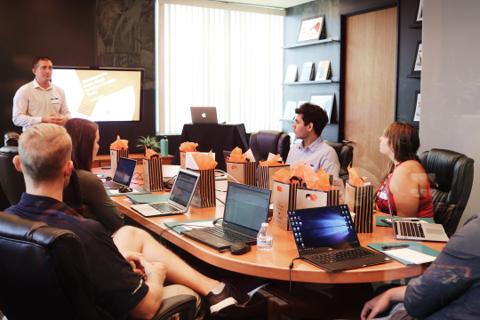Step 1: Consulting Workshop – Identifying the Company’s Needs
Objective: To thoroughly understand the organization’s goals, challenges, and specific requirements for employee development.
We began our engagement with a two-day on-site consulting workshop involving key stakeholders, including HR leaders, department heads, and team leads. During this phase, we:
- Conducted interviews to understand the skill gaps across various levels.
- Assessed the company's goals for integration, training, and leadership development.
- Identified cultural and operational challenges faced by the international workforce.
Findings:
- A need for tailored business skills training, including communication, conflict resolution, and time management.
- Development gaps among team leads in leadership and delegation.
- A desire for ongoing support to ensure continuous improvement.
- Strategic Workforce Planning for the Future
- Identifying current and future skill gaps in your workforce.
- Aligning workforce capabilities with long-term business goals.
- Leveraging AI to predict workforce trends and plan for future needs.
- Reskilling and Upskilling Roadmaps
- Designing tailored learning paths for employees at all levels.
- Prioritizing critical skills for emerging technologies and market demands.
- Integrating reskilling and upskilling programs into existing HR systems.
- Talent Management for Business Growth
- Attracting and retaining top talent in competitive industries.
- Using AI-driven tools to identify high-potential employees.
- Creating personalized career development plans to boost engagement and retention.
- Building a Culture of Continuous Learning
- Encouraging employees to embrace lifelong learning and adaptability.
- Implementing systems to reward skill development and innovation.
- Fostering a mindset of growth and agility across teams.
- Leadership Development for Reskilling Initiatives
- Training leaders to champion reskilling and upskilling efforts.
- Developing leadership skills for managing hybrid and diverse teams.
- Building emotional intelligence and decision-making capabilities in leaders.
- Change Management for Workforce Transformation
- Preparing employees for organizational changes driven by reskilling needs.
- Communicating the value of upskilling initiatives to reduce resistance.
- Supporting employees during transitions with coaching and training.
- Optimizing Talent Management Systems
- Streamlining recruitment, onboarding, and internal mobility processes.
- Using predictive analytics to identify future talent needs.
- Measuring the ROI of talent management and reskilling programs.
- Diversity and Inclusion in Talent Development
- Ensuring reskilling and upskilling programs are inclusive and equitable.
- Addressing unconscious bias in talent management processes.
- Promoting diversity as a driver of innovation and business success.
- AI-Driven Insights for Workforce Development
- Leveraging AI to analyze employee performance and identify skill gaps.
- Using data-driven insights to personalize training and development plans.
- Tracking progress and measuring the impact of reskilling initiatives.
- Global Talent Integration and Cultural Alignment
- Supporting businesses in integrating international talent effectively.
- Addressing cultural challenges in global teams.
- Designing onboarding programs for seamless integration of diverse employees.
Reskilling and Upskilling: Essential for staying competitive in industries disrupted by technology and innovation.
Talent Management: Critical for retaining top talent, reducing turnover, and ensuring long-term business growth.
Leadership Development: Necessary to drive workforce transformation and create a culture of adaptability.
Step 2: Tailored Training Program – Equipping Teams with Core Skills
Although this Website may be linked to other websites, we are not, directly or indirectly, implying any approval, association, sponsorship, endorsement, or affiliation with any linked website, unless specifically stated herein.
You should carefully review the legal statements and other conditions of use of any website which you access through a link from this Website. Your linking to any other off-site pages or other websites is at your own risk.
Timeline: Delivered two weeks after the consulting workshop.
Focus Areas: Addressing identified gaps with targeted training for different levels within the organization.
We rolled out a two-week training program comprising workshops tailored to the skill levels and roles of the participants:
- Entry-Level and Mid-Level Employees:
- Business communication in a multicultural setting.
- Time and priority management.
- Collaboration tools and strategies.
- Team Leads:
- Advanced leadership techniques.
- Managing cross-cultural teams.
- Conflict resolution and team motivation.
Website may use cookies to personalize and facilitate maximum navigation of the User by this site. The User may configure his / her browser to notify and reject the installation of the cookies sent by us.
Step 3: One-on-One Coaching – Supporting Leadership Development
Timeline: Initiated one month after the training program.
Objective: To provide tailored support to team leads, enabling them to apply their new skills effectively and drive team performance.
We assigned experienced coaches to work with team leads in bi-weekly one-on-one sessions. These sessions focused on:
- Implementing leadership strategies in real-world scenarios.
- Overcoming individual challenges in managing diverse teams.
- Setting long-term goals for professional and team development.
Although this Website may be linked to other websites, we are not, directly or indirectly, implying any approval, association, sponsorship, endorsement, or affiliation with any linked website, unless specifically stated herein.
You should carefully review the legal statements and other conditions of use of any website which you access through a link from this Website. Your linking to any other off-site pages or other websites is at your own risk.
Impact:
- Team leads demonstrated improved decision-making and conflict resolution skills.
- Productivity and team morale increased significantly.
- Leaders developed a stronger sense of ownership and confidence in their roles.
Reach out or Book a Meeting












